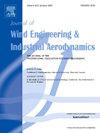通过综合数值和统计建模优化垂直风洞设计
IF 4.9
2区 工程技术
Q1 ENGINEERING, CIVIL
Journal of Wind Engineering and Industrial Aerodynamics
Pub Date : 2025-09-10
DOI:10.1016/j.jweia.2025.106218
引用次数: 0
摘要
本文以液滴悬浮垂直风洞为研究对象,提出了一种用于风洞设计的数学优化(元建模)方法。一个强大的,相互关联的反馈方法集成组件的尺寸和布局内的数值工具计算流分析。对导叶的数值分析使损失系数(Re≈0.2×106低至0.03,Re≈15000低至0.18)最小化,并优化了风洞尺寸。该方法不依赖于直观的或基于文献的参数选择,而是使用响应面近似来解决多变量设计问题。由Navier-Stokes解导出的昂贵函数的统计模型解释了非线性和不连续的行为。提出的方法根据用户定义的目标(例如,测试截面尺寸、湍流强度、压力损失)确定最佳隧道设计,并通过数值模拟对其进行验证。此外,该方法通过仅使用26个数值运行来求解四变量约束多目标函数,大大减少了对完整Navier-Stokes模拟的需要。这提高了计算效率,同时可以使用一组模拟在广泛的设计目标上进行优化。本文章由计算机程序翻译,如有差异,请以英文原文为准。
Optimizing vertical wind tunnel design through integrated numerical and statistical modeling
This paper presents a mathematical optimization (meta-modeling) approach for wind tunnel design, focusing on a vertical wind tunnel for droplet levitation. A robust, interconnected feedback methodology integrates component sizing and layout within a numerical tool for computational flow analysis. Numerical analysis of guide vanes minimizes the loss coefficient (as low as 0.03 for and 0.18 for ) and optimizes wind tunnel dimensions. Rather than relying on intuitive or literature-based parameter choices, the method solves a multi-variable design problem using response surface approximations. Statistical models of expensive functions – derived from Navier–Stokes solutions – account for non-linear and discontinuous behavior. The proposed methodology identifies optimal tunnel designs based on user-defined targets (e.g., test section size, turbulence intensity, pressure loss) and validates them via numerical simulation. Moreover, the approach significantly reduces the need for full Navier–Stokes simulations by using only 26 numerical runs to solve four-variable constrained multi-objective functions. This enhances computational efficiency while enabling optimization across a wide range of design targets using a single set of simulations.
求助全文
通过发布文献求助,成功后即可免费获取论文全文。
去求助
来源期刊
CiteScore
8.90
自引率
22.90%
发文量
306
审稿时长
4.4 months
期刊介绍:
The objective of the journal is to provide a means for the publication and interchange of information, on an international basis, on all those aspects of wind engineering that are included in the activities of the International Association for Wind Engineering http://www.iawe.org/. These are: social and economic impact of wind effects; wind characteristics and structure, local wind environments, wind loads and structural response, diffusion, pollutant dispersion and matter transport, wind effects on building heat loss and ventilation, wind effects on transport systems, aerodynamic aspects of wind energy generation, and codification of wind effects.
Papers on these subjects describing full-scale measurements, wind-tunnel simulation studies, computational or theoretical methods are published, as well as papers dealing with the development of techniques and apparatus for wind engineering experiments.

 求助内容:
求助内容: 应助结果提醒方式:
应助结果提醒方式:


